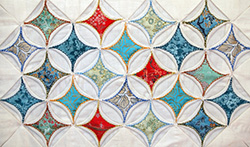Introduction
Consider the art of quilt making. A quilt is usually made using small figures sewn together to form a pattern. Some quilts are made from the same figures just turned or flipped over while others are made from different sizes and different figures in certain arrangements.
In this lesson, we will solve problems involving transformations of congruent figures and triangles.


Following successful completion of this lesson, students will be able to...
- Identify transformations
Essential Questions
- What are the differences between isosceles, scalene, and equilateral triangles?
- What are the differences between acute, right, and obtuse triangles?
- How do you find the perimeter and area of a triangle in the coordinate plane?
- What information is needed to show that two triangles are congruent?
- What information is needed to show that two figures are congruent?
Enduring Understandings
- The symmetry of polygons can be described in rotations and reflections.
- The sum of the interior angles of any triangle is a constant.
- The perimeter and area of a polygon can be calculated using its x and y coordinates.
- Congruence can be used to prove theorems about triangles.
The above objectives correspond with the Alabama Course of Study: Geometry with Data Analysis standards: 21b.